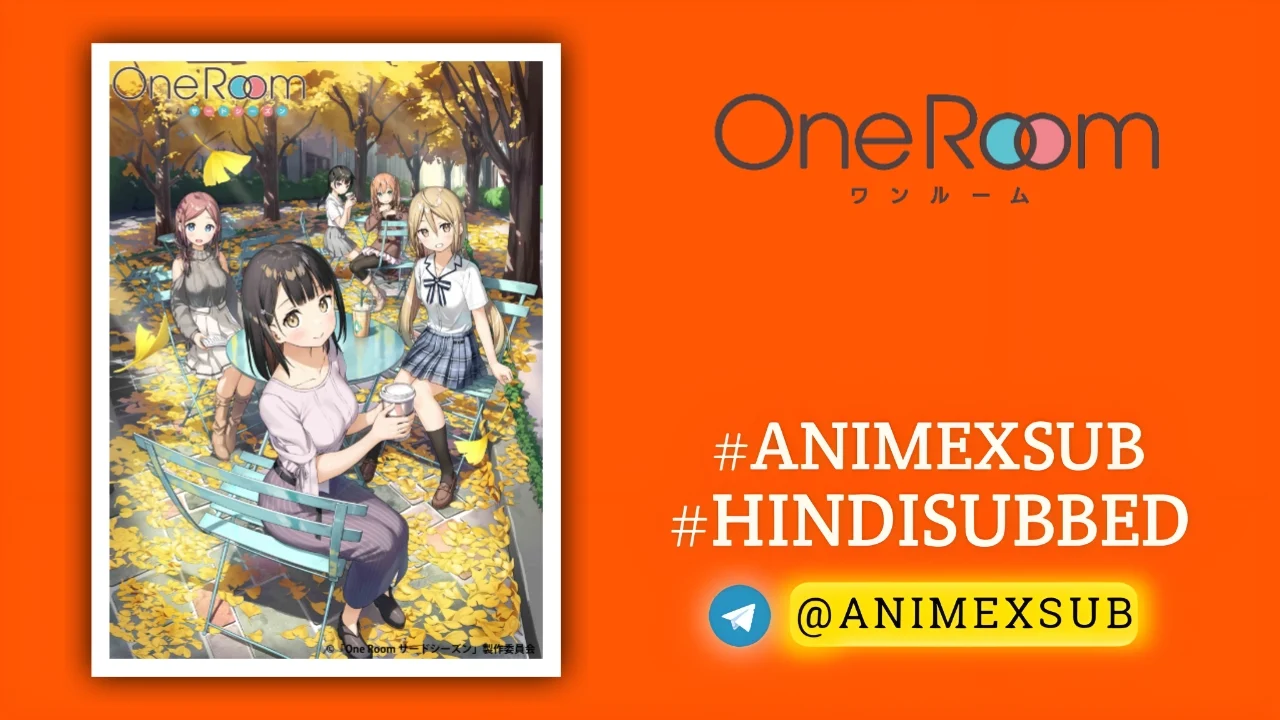
One Room Season 1 Hindi Subbed [12/12] {Complete}

One Room
OneRoomSynopsis
Having just moved into a new apartment building, Yui Hanasaka makes a customary visit to greet her neighbor. When she learns that he is an upperclassman at the university she aspires to attend, she asks for his help to pass her entrance exams. Meanwhile, Natsuki Momohara decides to visit her older brother, who lives alone in an apartment in Tokyo. Elsewhere, aspiring singer Moka Aoshima reunites with her childhood friend, who is a hopeful novelist. Three stories, although seemingly unrelated, contain the same essence: strings of fate will bind together those who share the same destiny, and one needs to look no further than a single apartment room.
Watch Trailer
Characters
One Room Season 1: A Quiet Revolution in Anime Storytelling
In the vast landscape of anime, where sprawling epics and high-octane action often dominate, One Room Season 1 (2017) carves out a niche that is as audacious as it is understated. This Japanese short-form anime, produced by SMIRAL and animated by Typhoon Graphics, redefines intimacy in storytelling through its innovative first-person perspective and minimalist narrative structure. Clocking in at just four minutes per episode across its 12-episode run, One Room challenges conventional anime tropes, offering a deeply personal, emotionally resonant experience that lingers long after its brief runtime. This article delves into the unique elements that make One Room Season 1 a groundbreaking exploration of human connection, examining its narrative approach, character depth, and cultural significance without veering into promotional territory.
The Premise: You Are the Protagonist
At its core, One Room is an omnibus series comprising three distinct stories, each centered on a different young woman—Yui Hanasaka, Natsuki Momohara, and Moka Aoshima—whose lives intersect with the viewer, cast as the silent male protagonist. The first-person perspective places the audience directly in the narrative, with the camera serving as the protagonist’s eyes. This bold choice eliminates the traditional barrier between viewer and story, creating an immersive experience that feels less like watching and more like living within the moment.
The setting is deceptively simple: a single apartment room, the titular “one room,” where each arc unfolds. Yui, a high school student preparing for university entrance exams, seeks tutoring from her neighbor (you). Natsuki, a spirited middle schooler, visits her older brother (you) in Tokyo during summer vacation. Moka, an aspiring singer, reconnects with her childhood friend (you), a budding novelist. While these premises sound familiar—echoing well-worn anime archetypes like the studious girl, the energetic little sister, and the nostalgic childhood friend—the execution transcends cliché through its focus on quiet, authentic moments of connection.
A Masterclass in Minimalism
One Room’s four-minute episodes are a testament to the power of brevity. In an era where anime often leans on extended runtimes to flesh out world-building or character arcs, One Room distills its storytelling to the essentials. Each episode captures a single, fleeting interaction—a study session, a playful argument, a heartfelt confession—yet these moments carry profound emotional weight. The series’ structure forces the writers to prioritize subtext and nuance over exposition, trusting the audience to fill in the gaps. This restraint is refreshing in a medium often criticized for over-explaining.
The animation, handled by Typhoon Graphics, complements this minimalist ethos. The visuals are clean and unembellished, with soft color palettes and detailed backgrounds that ground the apartment setting in a tangible sense of place. The character designs by Kantoku are expressive yet restrained, avoiding the exaggerated features common in many anime. This visual simplicity enhances the series’ intimacy, drawing attention to subtle gestures—a shy glance from Yui, Natsuki’s playful pout, or Moka’s wistful smile—that convey volumes about their inner worlds.
The sound design is equally understated, with sparse background music that allows the characters’ voices and ambient sounds (like the hum of a fan or the clink of dishes) to take center stage. The opening themes—Harumachi Clover by MAO (episodes 1–4), Natsuzora Yell by Rie Murakawa (episodes 5–8), and Kibō Refrain by Suzuko Mimori (episodes 9–12)—are short but evocative, each tailored to its respective heroine’s personality and arc. These elements combine to create a sensory experience that feels intimate and lived-in, as if the viewer is truly sharing space with these characters.
Character Depth in Four-Minute Bursts
Despite its brevity, One Room crafts surprisingly nuanced characters. Yui Hanasaka, the first arc’s focus, is a determined yet vulnerable high schooler navigating the pressures of university entrance exams. Her interactions with the protagonist reveal a mix of ambition and self-doubt, with subtle moments—like her nervous fidgeting during a study session—hinting at her fear of failure. Natsuki Momohara, the second heroine, brings a burst of energy as the protagonist’s younger sister. Her arc explores sibling dynamics, blending playful teasing with moments of genuine affection that highlight the complexities of familial bonds. Moka Aoshima, the final heroine, carries a melancholic air as an aspiring singer reconnecting with her childhood friend. Her story delves into themes of nostalgia and unfulfilled dreams, culminating in a poignant reflection on growing up.
What sets these characters apart is how they evolve through interaction rather than monologue. Because the protagonist is silent, the heroines’ dialogue and actions drive the narrative, revealing their personalities organically. For example, Yui’s growth from a nervous student to a confident examinee is shown through her increasing ease in the protagonist’s presence, not through explicit declarations. This approach respects the audience’s intelligence, allowing viewers to infer emotional depth from small, carefully crafted details.
The First-Person Gimmick: Innovation or Limitation?
The first-person perspective is One Room’s most polarizing feature. By making the viewer the protagonist, the series creates a sense of immediacy that is rare in anime. You don’t just watch Yui study; you feel like you’re the one quizzing her. You don’t just observe Natsuki’s antics; you’re the one she’s teasing. This immersion can be powerful, particularly for viewers who connect with the series’ slice-of-life tone. However, it also imposes limitations. The protagonist’s silence means their personality is a blank slate, which can make interactions feel one-sided. Some viewers may find this approach alienating, as it demands active emotional investment to fill in the protagonist’s side of the relationship.
Moreover, the POV style sacrifices traditional narrative depth for intimacy. There’s no overarching plot or complex world-building, which may disappoint viewers accustomed to more conventional anime. The series’ focus on everyday moments—studying, cooking, reminiscing—prioritizes emotional texture over dramatic stakes. Yet, this is precisely where One Room excels: it finds profundity in the mundane, suggesting that life’s most meaningful connections often occur in quiet, unremarkable spaces.
Cultural and Thematic Resonance
One Room taps into Japanese cultural themes of transience and connection, echoing the concept of mono no aware—the bittersweet awareness of life’s impermanence. Each heroine’s arc feels like a fleeting moment in time, a snapshot of a relationship that could deepen or fade. This transient quality is reinforced by the series’ setting: a single room, a temporary space that symbolizes the impermanence of youth, ambition, and even love. The apartment becomes a microcosm of life’s fleeting encounters, a place where destinies briefly intersect before diverging.
The series also subtly critiques societal pressures. Yui’s arc reflects the intense academic expectations placed on Japanese youth, where entrance exams can define one’s future. Natsuki’s story touches on the urban-rural divide, with her Hokkaido roots contrasting the fast-paced anonymity of Tokyo. Moka’s narrative explores the tension between artistic dreams and practical realities, a universal struggle for creatives. These themes are never heavy-handed, woven into the dialogue and interactions with a light touch that invites reflection rather than preaching.
Critical Reception and Legacy
One Room Season 1 has garnered mixed reception, reflecting its experimental nature. On platforms like MyAnimeList, reviews praise its unique perspective and emotional resonance but criticize its lack of plot and character depth due to the short runtime. A Reddit thread from 2020 questions whether the series is worth watching, citing its low ratings but acknowledging its cult appeal. Some viewers appreciate the series’ departure from anime norms, while others find its simplicity underwhelming. A YouTube review describes it as “interesting” but notes the challenge of connecting with a silent protagonist.
Despite its polarizing reception, One Room’s influence is undeniable. Its success spawned two more seasons (2018 and 2020) and a spin-off, Room Mate, aimed at female audiences with male protagonists. The 2024 release of One Room: Yui Hanasaka Memorial, an animated novel game, further cements Yui’s status as the series’ breakout character, offering fans a deeper dive into her story. The series’ “subjective perspective” has inspired discussions about immersive storytelling in anime, paving the way for other experimental projects.
Why One Room Matters
One Room Season 1 is not for everyone. Its lack of a traditional plot and reliance on viewer investment may frustrate those seeking action or complexity. Yet, its simplicity is its strength. By stripping away the excesses of modern anime, it offers a pure, unfiltered look at human connection. The series reminds us that profound stories don’t need epic battles or sprawling casts—just a room, a moment, and two people finding common ground.
In a medium often defined by spectacle, One Room dares to be small. It dares to be quiet. And in that quiet, it finds a powerful voice, speaking to the universal longing for connection in a transient world. Whether you see it as a bold experiment or a charming curiosity, One Room Season 1 is a testament to the idea that sometimes, less is infinitely more.
Support Our Anime Community!
Love watching the latest anime? Help us keep uploading new episodes by join telegram channel ❤️
Join Now!







